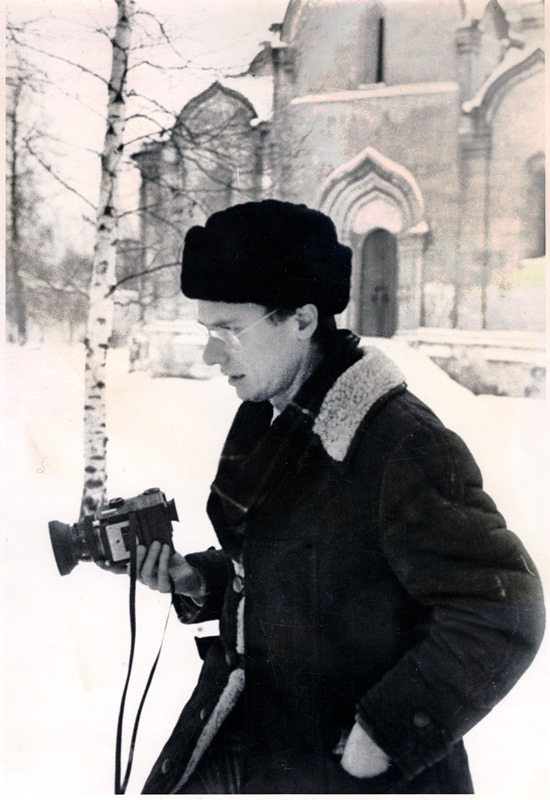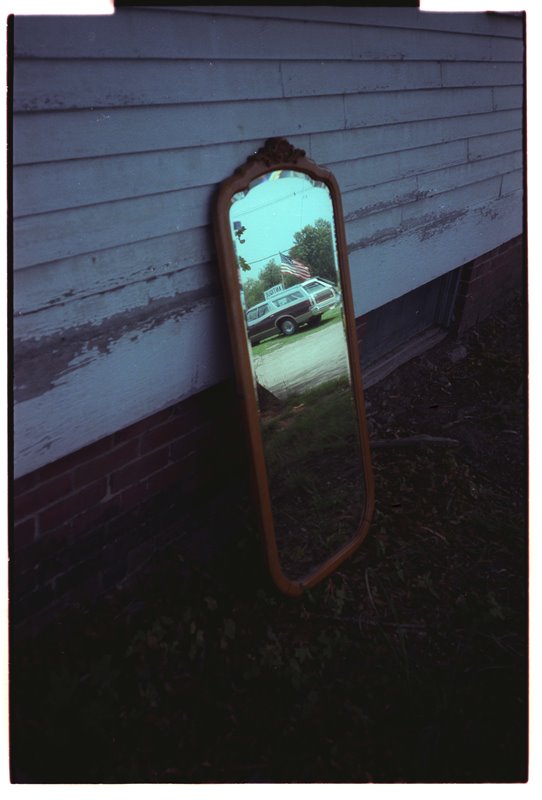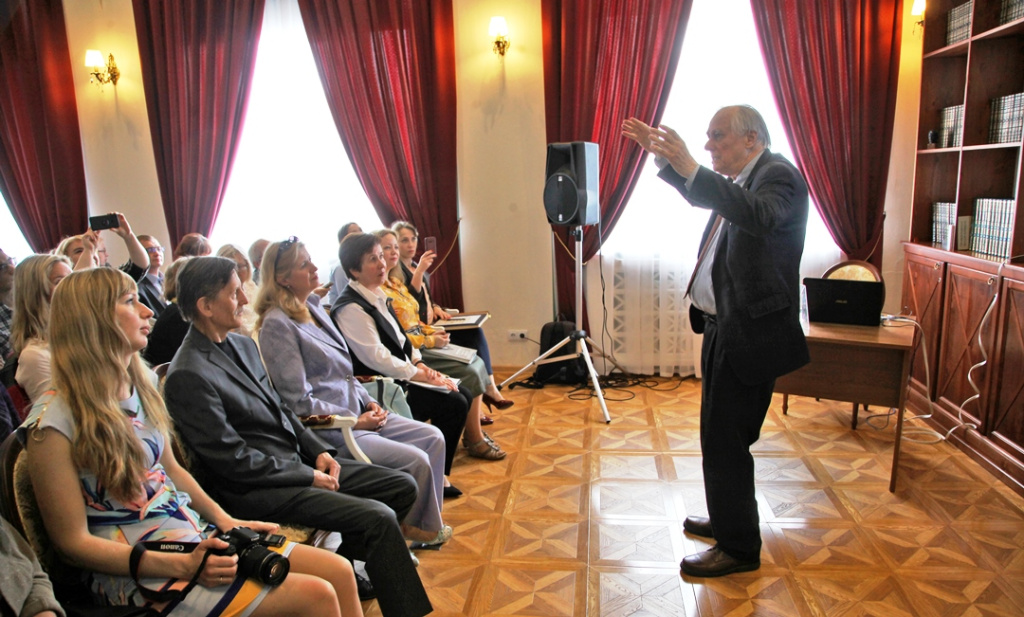
William Brumfield: “Russians Have Remarkable Perception of Art”
/ Главная / Russkiy Mir Foundation / Publications / William Brumfield: “Russians Have Remarkable Perception of Art”William Brumfield: “Russians Have Remarkable Perception of Art”
William Brumfield. Dudinka (Krasnoyarsk Krai), 2014. Photo courtesy of William Brumfield
William Brumfield, a contemporary American historian of Russian architecture, a preservationist and an architectural photographer, has recently become a Russian citizen. At the same time Brumfield’s exhibition The Silent America was opened at the Shchusev Museum of Architecture in Moscow. The brilliant scholar and a sophisticated photographer opens the world of provincial America to the Russian viewers.
William Brumfield has been building bridges between Russia and the United States for more than half a century. Currently, he is sorting out his photo archive to hand it over to the US National Gallery of Art. This American treasure trove has tens of thousands of images featuring Russian churches. Finally the Silent America project has arrived in Moscow. Mr. Brumfield is looking forward to see the exhibition touring all over Russia.
During his interview with the Russky Mir, William Brumfield spoke about the unique Russian perception, which makes his art understood deeper in Russia than in the U.S.
In Recognition of Merits for Russian Culture
The Kremlin's website published a presidential decree on granting Russian citizenship to William Brumfield, a Slavist and professor at the Tulane University of Louisiana. In late July, the scholar received a passport with a double-headed eagle at the Russian Embassy. "This is an achievement, this is a pinnacle event," he said in his interview with the Russkiy Mir, adding that Russian citizenship will make his visits to our country easier and facilitate his research work. Despite the considerable age (he will be 80 next year), Mr. Brumfield intends to continue great part of his work in Russia. There are many unexplored churches as well, although he has traveled the country through its length and breadth.
The scientist was granted citizenship in recognition of his merits for Russia, as well as for his efforts in preserving its history and architecture. Moreover, these merits cannot fit an average bookshelf: Mr. Brumfield has published dozens of books for Russian and American readers and researchers.
It is impossible to think of Mr. Brumfield the explorer without a camera. He makes no secret of the fact that he has seen (and fallen in love for good with) Russia not only through his eyes but also through his camera lens. The American scholar first came to Moscow as part of a teacher's exchange program with Moscow State University in 1970. His photographs printed from the developed film struck him no less than the things he had seen and experienced back then.

St. Andronicus Monastery (Moscow), 1979. Photo courtesy of William Brumfield
At the time he was teaching Russian language and literature at the University of California. William Brumfield took only 3 or 4 filmrolls on his first Soviet assignment. They have finished in no time.
"We had tours around the historic part of the city, and I was fascinated by the beauty and uncommon forms," he shared in a video message preceding the opening of the exhibition in Moscow. "When I came back and developed the film, I was stunned."
Mr. Brumfield visited Russia on a regular basis. Sometimes he stayed for six months at a time. Nevertheless, the feelings he experienced on the first visit have remined with him to this day.
"Russia has always inspired me."
Silent America by William Brumfield is an exhibition of photographs he took as a young man. He has captured abandoned and ruined buildings mostly in the South of America where he was brought up; and later New England where he taught at Harvard University after completing his doctorate in the 1970s. The exhibition shows the scholar as an artist reflecting on the perishable and flow of time.
– The original title of your exhibition is Lost America, which means "vanished" or "gone" America…
– At the end, the curator has chosen an optimal title, Silent America. The word “lost” has some negative nuances, and we wanted to avoid any political connotations. Everything is simple. I had an exhibition and a very popular book dedicated to the ruins of Russian architecture, titled "Lost Russia". "Silent America" is not a documentary or lyrical project, but purely artistic one.
– How was it born?
– When I was teaching at Harvard, I decided to write a large volume on Russian architecture and use my photographs. I bought a professional camera for this project, and made about a thousand photographs of Russian architectural monuments by that time.
I used to think that I needed the equipment to shoot in Russia but then I started to see photography as a form of art. So, I took photographs of abandoned and forgotten places in America, such as ruins and streets, rather than monuments. That's where I discovered my artistic identity. We build and create, and then it takes on a life of its own – it’s kind of a mystery.

The photograph from W. Brumfield's exhibition " Silent America". Vermont, 1978. Photo courtesy of William Brumfield
Obviously, some objects can't and shouldn't be photographed. However, this is what the artist's role is about. Finding the right object and the right time. The image is empowered by composition, light, shading, dynamics, and texture. I came to discover myself as an artist in America, although my Russian work had been a trigger for that. Do you see the complicated interaction between the two? I wouldn't have even thought about photography without Russia.
– So Russia made you discover America …
- You could put it this way as well. Russia opened my eyes to the essence of art. One section is dedicated to granite and water. I took photographs on the Maine coast. Granite and water are the basic elements of our planet, both in the geological and biblical senses. It's about water and land, the creation of the world. I used to photograph abandoned structures and forgotten political posters earlier. The time goes by. As the ancient Greeks explained, things are changing continuously, and photography captures this process and makes us think about the flow of time.
– Is it a surprise to you that an exhibition dedicated to America has now opened in Moscow?
– Negotiations over the exhibition commenced about four years ago. I have been cooperating with the Museum of Architecture since 1979. In 2001, it hosted a huge exhibition entitled "The Russian North: The Visual Testimony of William Brumfield". However, this exhibition is quite different. When I mentioned my works and showed some of them, the museum staff understood everything at once. This is an important question, why do Russians perceive the essence of art so well? We signed a contract, yet the project was postponed due to the pandemic. Then it got more complicated. Nevertheless, the museum management kept their word as they did realize that this exhibition was not about architecture only but also about art and aspirations. Politics has no role to play here, it is on a different level.
– You mentioned the Russian perception of culture and art. What makes it special?
– Perhaps it has something to do with iconographic traditions. I don't know what the peculiarity is, I am trying to find an answer. I can see how my work is perceived in Russia and the West. Over there, they ask, "Who are you? What is your education?" Whereas in Russia, they looked at my photographs and understood them, they recognized their power. I was elected a member of the Russian Academy of Arts as a historian and as an artist. One might think, why in Russia and not in America? Russia has always inspired me, since the very first moment. It's amazing.

Lecture by W. Brumfield in Vologda, 2019. Photo credit: Alexei Kolosov
– Many people in Russia admire the classic America that they probably saw in the movies. Has it survived and did it even exist?
- Yes but no. There are a lot of stereotypes in that, of course, and everything depends on the particular movie. I believe music is a more reliable portal to understanding. The places that I found in America and photographed are my home grounds. My mom was born in North Carolina and my dad is from Louisiana. That's my family background and it's important to me. However, this is not the point for the public. My photographs show abandoned buildings, and Russians recognize them with astonishing accuracy. It makes sense to me and yet it is a mystery. How come people from a different culture are so accurate in their guessing?
– Well, speaking of changing times. You often include pre-revolutionary photographs by Sergey Prokudin-Gorsky in your articles, as well as your photos of the same place in Russia taken in different years. And all these photos are different, although the temple has not changed much. Why does this happen?
– My and his views and perspectives are different. Also, cameras and lenses are different, that's important, too. This is also the great puzzle of photography as an art. The photograph captures the moment but it makes us think about the process, the eternal. We look at a photograph taken by Mr. Prokudin-Gorsky and start thinking, what happened after that? We look at my photographs and think, what happened before that?
– So your photo of a particular temple taken, let's say, in 2018 does not negate the value of photos of the same temple taken in earlier years, does it?
– Absolutely. That's why my archive is so valuable. I can actually date my photos. Since the 1960s, I've been keeping a record of what I do every day. I wouldn't call it a diary but these notes have been very useful in building my archive. The moment captured by the photographer is very important but the information of when it was taken is just as important.
– How old were you when you realized that you capture history when you are taking photos of the here and now?
– I have no idea, God has ordered it so, it is God's Providence. I certainly didn't realize it when I started but I sensed it. Sometimes the artwork is smarter than the person. The artistic process is a great mystery.
– You mentioned that you have been actively working on your archive of photographs of Russian architecture taken over decades. How does this take place?
– My students and I have completed a huge task. We scanned my entire color collection, which includes about 100,000 photos, and scanned about 20% of the black and white photos. I identify all the photos and indicate what, where, and when was captured. Then I hand this material over to the National Gallery of Art, and they preserve it. There are other websites in Russia that display this material.
Besides the above work, I am writing a big book on wooden architecture. There are excellent books on this subject in Russia. Yet this will be my personal perspective. It will include my photos from the 1970s and later. Many of the buildings seen in the photos no longer exist. My work still inspires me at the age of 79, and I do have tasks to accomplish, including research, archiving, and teaching.
– Are American students interested in your work in Russia?
- Yes, there are enthusiastic people. They are a few but I am very happy to stay in touch with them.
New publications

 Mikhail Kalatozov, a director who transformed the world of cinematography in many ways, was born 120 years ago. He was a Soviet film official and a propagandist. Above all, he was capable of producing movies that struck viewers with their power and poetic language.
Mikhail Kalatozov, a director who transformed the world of cinematography in many ways, was born 120 years ago. He was a Soviet film official and a propagandist. Above all, he was capable of producing movies that struck viewers with their power and poetic language.  Ukrainian authorities have launched a persecution campaign against the canonical Ukrainian Orthodox Church (UOC), the biggest one in the country's modern history. Over the past year, state sanctions were imposed on clergy representatives, searches were conducted in churches, clergymen were arrested, criminal cases were initiated, the activity of the UOC was banned in various regions of the country, and monasteries and churches were seized.
Ukrainian authorities have launched a persecution campaign against the canonical Ukrainian Orthodox Church (UOC), the biggest one in the country's modern history. Over the past year, state sanctions were imposed on clergy representatives, searches were conducted in churches, clergymen were arrested, criminal cases were initiated, the activity of the UOC was banned in various regions of the country, and monasteries and churches were seized.  When Nektary Kotlyaroff, a fourth-generation Russian Australian and founder of the Russian Orthodox Choir in Sydney, first visited Russia, the first person he spoke to was a cab driver at the airport. Having heard that Nektariy's ancestors left Russia more than 100 years ago, the driver was astonished, "How come you haven't forgotten the Russian language?" Nektary Kotlyaroff repeated his answer in an interview with the Russkiy Mir. His affinity to the Orthodox Church (many of his ancestors and relatives were priests) and the traditions of a large Russian family brought from Russia helped him to preserve the Russian language.
When Nektary Kotlyaroff, a fourth-generation Russian Australian and founder of the Russian Orthodox Choir in Sydney, first visited Russia, the first person he spoke to was a cab driver at the airport. Having heard that Nektariy's ancestors left Russia more than 100 years ago, the driver was astonished, "How come you haven't forgotten the Russian language?" Nektary Kotlyaroff repeated his answer in an interview with the Russkiy Mir. His affinity to the Orthodox Church (many of his ancestors and relatives were priests) and the traditions of a large Russian family brought from Russia helped him to preserve the Russian language.

 The leaders of the Friends of the Great Russia cultural association (Amici Della Grande Russia) in Italy believe that the Western policy of abolishing Russian culture in Europe has finally failed. Furthermore, it was doomed to failure from the beginning.
The leaders of the Friends of the Great Russia cultural association (Amici Della Grande Russia) in Italy believe that the Western policy of abolishing Russian culture in Europe has finally failed. Furthermore, it was doomed to failure from the beginning.  Name of Vladimir Nemirovich-Danchenko is inscribed in the history of Russian theater along with Konstantin Stanislavski, the other founding father of the Moscow Art Theater. Nevertheless, Mr. Nemirovich-Danchenko was a renowned writer, playwright, and theater teacher even before their famous meeting in the Slavic Bazaar restaurant. Furthermore, it was Mr. Nemirovich-Danchenko who came up with the idea of establishing a new "people's" theater believing that the theater could become a "department of public education."
Name of Vladimir Nemirovich-Danchenko is inscribed in the history of Russian theater along with Konstantin Stanislavski, the other founding father of the Moscow Art Theater. Nevertheless, Mr. Nemirovich-Danchenko was a renowned writer, playwright, and theater teacher even before their famous meeting in the Slavic Bazaar restaurant. Furthermore, it was Mr. Nemirovich-Danchenko who came up with the idea of establishing a new "people's" theater believing that the theater could become a "department of public education."  "Russia is a thing of which the intellect cannot conceive..." by Fyodor Tyutchev are famous among Russians at least. December marks the 220th anniversary of the poet's birth. Yet, he never considered poetry to be his life's mission and was preoccupied with matters of a global scale. Mr.Tyutchev fought his war focusing on relations between Russia and the West, the origins of mutual misunderstanding, and the origins of Russophobia. When you read his works today, it feels as though he saw things coming in a crystal ball...
"Russia is a thing of which the intellect cannot conceive..." by Fyodor Tyutchev are famous among Russians at least. December marks the 220th anniversary of the poet's birth. Yet, he never considered poetry to be his life's mission and was preoccupied with matters of a global scale. Mr.Tyutchev fought his war focusing on relations between Russia and the West, the origins of mutual misunderstanding, and the origins of Russophobia. When you read his works today, it feels as though he saw things coming in a crystal ball...